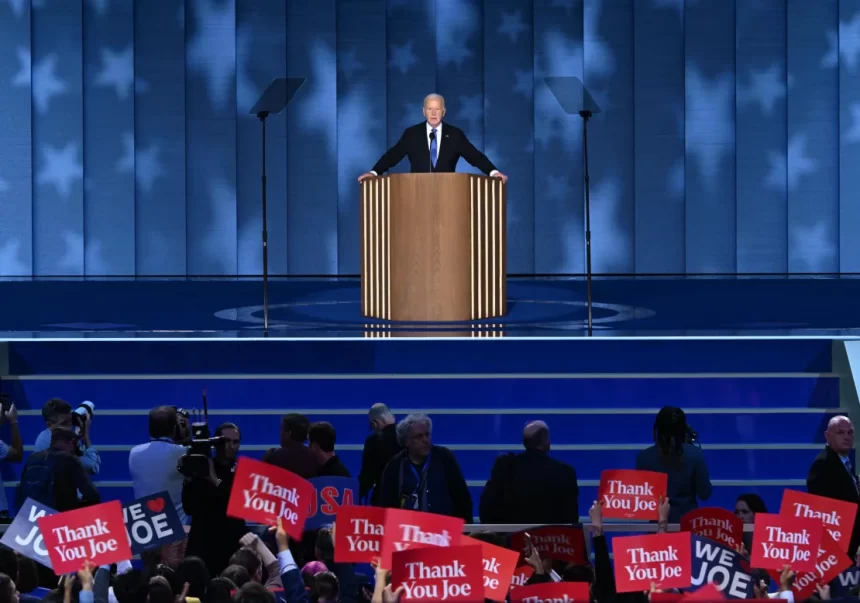During his speech, Biden asked the audience if they knew what the average billionaire in the United States pays in taxes.
“We have a thousand billionaires in America. You know what the average tax rate they pay? 8.2%,” Biden said.
Facts First: Biden used this figure in a way that was misleading. As in previous remarks, including his State of the Union address in March, Biden didn’t explain that the figure is the product of an alternative calculation, from economists in his own administration, that factors in unrealized capital gains that are not treated as taxable income under federal law.
There’s nothing inherently wrong with the alternative calculation itself; the administration economists who came up with it explained it in detail on the White House website in 2021. Biden, however, has tended to cite the figure without any context about what it is and isn’t, leaving open the impression that he was talking about what these billionaires pay under current law.
So, what do billionaires actually pay under current law? The answer is not publicly known, but experts say it’s clearly more than 8%.
“Biden’s numbers are way too low,” Howard Gleckman, senior fellow at the Urban-Brookings Tax Policy Center at the Urban Institute think tank, told CNN in 2023. Gleckman said that in 2019, University of California, Berkeley, economists Emmanuel Saez and Gabriel Zucman “estimated the top 400 households paid an average effective tax rate of about 23% in 2018. They got a lot of attention at the time because that rate was lower than the average rate of 24% for the bottom half of the income distribution. But it still was way more than 2 or 3,” numbers Biden has used in some previous speeches, “or even 8%.”
In February 2024, Gleckman provided additional calculations from the Tax Policy Center. The center found that the top 0.1% of households paid an average effective federal tax rate of about 30.3% in 2020, including an average income tax rate of 24.3%.
From CNN’s Daniel Dale
Biden on carbon emissions
Speaking about his achievements on climate, Biden said his agenda made possible “cutting carbon emissions in half by 2030.”
Facts First: Independent analysis shows the US is off-track to meet an ambitious goal Biden set early in his administration of slashing US carbon emissions in half by 2030 – even with his climate law.
Biden’s climate target of cutting emissions 50-52% below 2005 levels (2005 was the historical peak for US carbon emissions) by 2030 was always going to be a tough goal to achieve. When the Inflation Reduction Act passed in 2022, analysis suggested it would get the US most of the way toward its goal – about a 40% reduction in carbon emissions. The thinking was that regulations from agencies like the Environmental Protection Agency would help make up the rest of the goal.
But a recent analysis from the nonpartisan Rhodium Group found that the US isn’t on track to hit Biden’s goal of slashing US emissions in half by 2030. Rhodium estimates the US is currently on track to reduce emissions anywhere from 32-43% by that date. However, the report says the US could surpass Biden’s goal by 2035 if there are no major changes to current policies, finding that the US would likely pick up the pace of decarbonizing its transportation, power and heavy industry sectors in the 2030s compared to the 2020s.
One big impediment to Biden’s goal is the fact that the EPA’s marquee climate rules regulating emissions from vehicles and power plants are facing an onslaught of legal challenges and a skeptical US Supreme Court. And an even bigger question mark is the 2024 election and whether Biden will be replaced by another Democrat with similar climate ambitions or former President Donald Trump – who has vowed to reverse much of Biden’s climate agenda.
From CNN’s Ella Nilsen
Biden’s claim about removing lead pipes from schools and homes
Biden, speaking about his bipartisan infrastructure law, said: “We’re removing every lead pipe from schools and homes, so every child can drink clean water.”
Facts First: This claim needs context. While the administration is spending $15 billion and working on federal regulations to remove all lead pipes from public drinking water systems over a decade, they may not be able to replace all pipes and service lines on private properties.
Lead drinking pipes can be found all over the country; some national estimates say the total number of lead service lines is around 9.2 million. Lead in drinking water is a major health concern for babies and young children, and Biden has made eradicating it a major priority. The Biden EPA proposed a major rule that, if finalized, would compel water utilities to gradually get rid of 100% of their lead pipes and service lines over 10 years.
The EPA estimates this effort will cost utilities $20 billion to $30 billion over that decade; $15 billion of that could be covered by the bipartisan infrastructure law, and there is an additional $11.7 billion available through the Drinking Water State Revolving Fund that could be used for lead removal as well. Cities with lead pipes, including New Orleans, are currently trying to locate all of their lead pipes.
The EPA’s rule as currently proposed does cover lead pipes and service lines on private property in addition to public, but replacing these smaller pipes on private property that go into homes could present a complex and costly challenge. Though the Biden initiative will make a major dent in replacing the country’s lead pipes, it could be difficult to be able to replace every single one on both private and public property.











rjche5